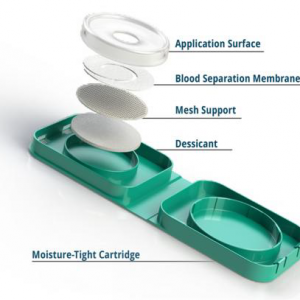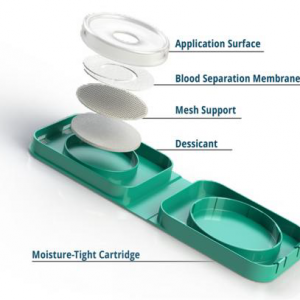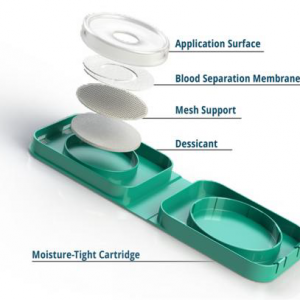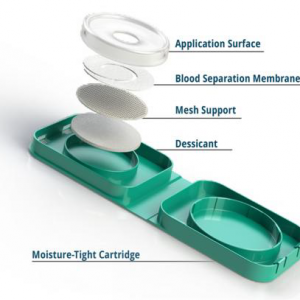Description
![]()
StatShell Information
Collection Instructions
Sample Lab Report
Unit: 1 Each
Contents: 1 Collection Kit (Instructions, Blood Collection Card, Lab Form, Blood Sample Return Bag, Prepaid Return Envelope, Wound Kit, Lab Processing, Results Reporting)
Determinations: Lipid Profile & Glycated Hemoglobin (HbA1c)
Storage Requirements: 59° – 86° F
The Lipid Profile / A1c Combo Collection Kit is an effective method of determining a patient’s risk for heart disease as well as for diabetes. Only a single finger stick is required to obtain a sample. In one week, a comprehensive report containing quantitative results will be issued, permitting physicians to make a prompt diagnosis and begin treatment.
The Lipid Profile test measures the amount of total cholesterol, triglycerides, HDL (high-density lipoprotein, “good cholesterol”), and calculated LDL (low-density lipoprotein, “bad cholesterol”) in blood. Each one is a distinctive type of fat that circulates in our blood. A certain amount of these fats are necessary for our bodies to function, particularly in maintaining cell membrane stability. However, having too much cholesterol in our blood can also be detrimental. It can cause deposits and build up in blood vessel walls, clogged arteries (known as atherosclerosis), and eventually blood clots leading to a heart attack or stroke. Knowing your cholesterol levels can help determine your risk of heart disease.
Unalterable Risk Factors for Coronary Disease:
- Age
- Gender – Males
- Menopausal decrease in Estrogen
- Family History
Alterable Risk Factors for Coronary Disease:
- High Blood Pressure
- High Cholesterol Levels
- Tobacco Smoking
- Excessive Alcohol Consumption
- Obesity
- Stress
- Air Pollution
- Lack of Exercise
Although coronary disease is the leading cause of death in the US, only 20% of those cases can be attributed to genetic risk factors. By focusing on diet, maintaining a healthy lifestyle, and regularly testing cholesterol levels, patients can be proactive in reducing their chances for heart disease.
The A1c (glycated hemoglobin or HbA1c) test reveals a snapshot of average blood glucose control for the past 2 to 3 months. These results can indicate how well a diabetes treatment plan is working or serve as a warning sign for a pre-diabetic condition.
Most Common Symptoms of Diabetes:
- Frequent urination
- Disproportionate thirst
- Intense hunger
- Weight gain
- Unusual weight loss
- Increased fatigue
- Irritability
- Blurred vision
- Slow healing or improperly healing wounds
- Increased skin and/or yeast infections
- Itchy skin
- Red, swollen, or receding gums
- Male sexual dysfunction
- Numbness or tingling in hands and feet
Non-diabetic patients fall within a normal A1c range of between 4.5 to 6 percent, whereas a range of 5.7 to 6.4 percent is a strong indicator for prediabetes. A patient that has already been diagnosed as diabetic customarily maintains an A1c level of 7 percent or less, while readings of 8 percent or higher indicate poor blood sugar management. Diabetic patients are advised to maintain daily blood glucose levels at or near the normal range of 70 mg/dl to 120 mg/dl before meals and under 140 mg/dl at 2 hours after meals. If the patient’s A1c level is above the target range, it is important that they consult with their physician about modifying their treatment plan.
Diabetes usually takes its toll slowly, gradually attacking the eyes, organs, and extremities. Continuous control is imperative. The Diabetes Control and Complication Trial (DCCT) has shown that the lower the A1c number, the better the patient’s chances of slowing or even preventing serious damage to the eyes, nerves, and kidneys. Any improvement in these numbers has the potential for reducing complications.
The American Diabetes Association (ADA) recommends the A1c test as the best method for determining a patient’s blood sugar control over an extended period of time. The ADA further recommends that patients test their A1c levels every 3 months if they are taking insulin, making changes to treatment, or during periods of high recorded blood sugar levels. Patients taking oral medications and those with stable blood sugar levels should take the test every 6 months.
Complete instructions are included, and sample collection is quite easy and virtually painless. A single finger stick using the enclosed lancet is all that is required to obtain the sample needed. Simply deposit the drops of blood on the collection card and wait a minimum of 10 minutes for it to dry. Then place the card in the enclosed postage paid return envelope along with your completed Laboratory Authorization Form, and drop in the nearest US mailbox.
After your sample has been analyzed at the Laboratory, you will receive a report by mail that clearly indicates if the results are normal or if a follow up with a health care provider is needed. Early detection of abnormal TSH levels greatly increases your chances for successful treatment.
Expect to receive your quantitative test results within one week from the time your test has been received by the Laboratory.
Lipid Profile & A1c Collection Kit (Mail-In) Includes:
Instructions
Blood Collection Card
Lab Form
Blood Sample Return Bag
Prepaid Return Envelope
Wound Kit
Lab Processing
Results Reporting
Wound Kit contains: (2) Lancets, Alcohol Prep Pad, Gauze and Band-aid




